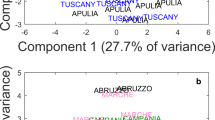Abstract
Complete fatty acid profile and major phytosterols of nearly all commercially available vegetable oils, obtained from local grocery stores in South Korea, were analyzed (n = 15). Subsequently, the contribution of specific oil components to antioxidative effects, measured using conventional 2,2-diphenyl-1-picrylhydrazyl (DPPH) and 2’,7’-dichlorofluorescindiacetate (DCF-DA) assays, was assessed via principal component analysis (PCA). The rat pheochromocytoma cell line was used for the DCF-DA analysis. One of the phytosterols (i.e., β-sitosterol) was positively correlated with DPPH and negatively correlated with the intracellular oxidative levels of neuronal cells, measured by DCF-DA. In addition, through the comparison between loading plot and score plot, groups of oils with similar properties were identified and their associations and unforeseen factors were elucidated by virtue of PCA. Taken together, the results herein suggest that the combination of chromatographic analysis and multivariate analysis could be a useful method to elucidate the role of responsible nutrients as well as associated similarities (or dissimilarities) of sample characteristics in biological outcomes.
Similar content being viewed by others
Literature Cited
Andersen PC, Gorbet DW. 2002. Influence of year and planting date on fatty acid chemistry of high oleic acid and normal peanut genotypes. J. Agric. Food Chem. 50:1298–1305.
Behl C. 1999. Alzheimer's disease and oxidative stress: implications for novel therapeutic approaches. Prog. Neurobiol. 57:301–323.
Dizdaroglu M, Nackerdien Z, Chao BC, Gajewski E, Rao G. 1991. Chemical nature of in vivo DNA base damage in hydrogen peroxidetreated mammalian cells. Arch. Biochem. Biophys. 285:388–390.
Haddada FM, Manai H, Oueslati I, Daoud D, Sanchez J, Osorio E, Zarrouk M. 2007. Fatty acid, triacylglycerol, and phytosterol composition in six Tunisian olive varieties. J. Agric. Food Chem. 55:10941–10946.
Hayden KM, Welsh-Bohmer KA, Wengreen HJ, Zandi PP, Lyketsos CG, Breitner JC. 2007. Risk of mortality with vitamin E supplements: the Cache County study. Am. J. Med. 120:180–184.
Jekel AA, Vaessen HAMG, Schothorst RC. 1998. Capillary gaschromatographic method for determining non-derivatized sterols-some results for duplicate 24 h diet samples collected in 1994.. Fresenius J. Anal. Chem. 360:595–600.
Kim JK, Choi SJ, Cho HY, Kim YJ, Lim ST, Kim CJ, Kim EK, Kim HK, Peterson S, Shin DH. 2010. Ipomoea batatas attenuates amyloid beta peptide-induced neurotoxicity in ICR mice. J. Med. Food 14:304–309.
Li FJ, Shen L, Ji HF. 2012. Dietary Intakes of Vitamin E, Vitamin C, and beta-Carotene and Risk of Alzheimer's Disease: A Meta-Analysis. J. Alzheimers Dis. 30:1–6.
Lopez A, Montano A, Garcia P, Garrido A. 2006. Fatty acid profile of table olives and its multivariate characterization using unsupervised (PCA) and supervised (DA) chemometrics. J. Agric. Food Chem. 54:6747–6753.
Lyras L, Cairns NJ, Jenner A, Jenner P, Halliwell B. 1997. An assessment of oxidative damage to proteins, lipids, and DNA in brain from patients with Alzheimer's disease. J. Neurochem. 68:2061–2069.
Mark RJ, Lovell MA, Markesbery WR, Uchida K, Mattson MP. 1997. A role for 4-hydroxynonenal, an aldehydic product of lipid peroxidation, in disruption of ion homeostasis and neuronal death induced by amyloid beta-peptide. J. Neurochem. 68:255–264.
Ngeh-Ngwainbi J, Lin J, Chandler A. 1997. Determination of total, saturated, unsaturated, and monounsaturated fats in cereal products by acid hydrolysis and capillary gas chromatography: collaborative study. J. AOAC. Int. 80:359–372.
Noh S, Yoon SH. 2012. Stereospecific positional distribution of fatty acids of Camellia (Camellia japonica L.) seed oil. J. Food Sci. 77:C1055–1057.
Ossani GP, Repetto MG, Boveris A, Monserrat AJ. 2012. The protective effect of menhaden oil in the oxidative damage and renal necrosis due to dietary choline deficiency. Food. Funct. 4:448–452.
Reiter RJ. 1995. Oxidative processes and antioxidative defense mechanisms in the aging brain. FASEB. J. 9:526–533.
Salminen A, Ojala J, Kauppinen A, Kaarniranta K, Suuronen T. 2009. Inflammation in Alzheimer's disease: amyloid-beta oligomers trigger innate immunity defence via pattern recognition receptors. Prog. Neurobiol. 87:181–194.
Shin E-C, Craft BD, Pegg RB, Phillips RD, Eitenmiller RR. 2010. Chemometric approach to fatty acid profiles in Runner-type peanut cultivars by principal component analysis (PCA). Food Chem. 119:1262–1270.
Su BL, Zeng R, Chen JY, Chen CY, Guo JH, Huang CG. 2012. Antioxidant and Antimicrobial Properties of Various Solvent Extracts from Impatiens balsamina L. Stems. J. Food Sci. 77:C614–619.
Sugie S, Okamoto K, Tanaka T, Mori H, Reddy BS, Satoh K. 1995. Effect of fish oil on the development of AOM-induced glutathione S-transferase placental form positive hepatocellular foci in male F344 rats. Nutr. Cancer 24:187–195.
Wolfe KL, Liu RH. 2007. Cellular antioxidant activity (CAA) assay for assessing antioxidants, foods, and dietary supplements. J. Agric. Food Chem. 55:8896–8907.
Yan MH, Wang X, Zhu X. 2013. Mitochondrial defects and oxidative stress in Alzheimer disease and Parkinson disease. Free Radic. Biol. Med. 62:90–101.
Author information
Authors and Affiliations
Corresponding author
Rights and permissions
About this article
Cite this article
Kim, J.K., Lim, HJ., Shin, DH. et al. Compositions of fatty acids and phytosterols of plant-based oils and their associations with anti-oxidative capacity: Application of principal component analysis. Hortic. Environ. Biotechnol. 56, 561–567 (2015). https://doi.org/10.1007/s13580-015-0060-y
Received:
Revised:
Accepted:
Published:
Issue Date:
DOI: https://doi.org/10.1007/s13580-015-0060-y




